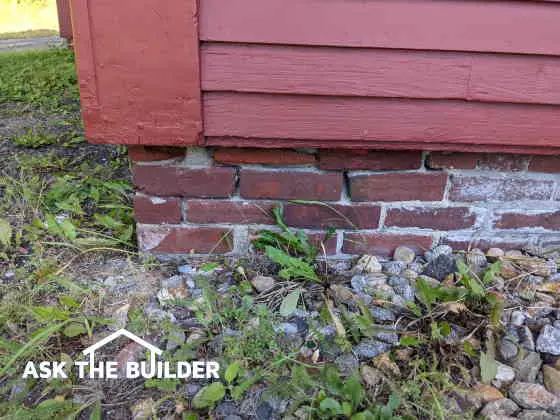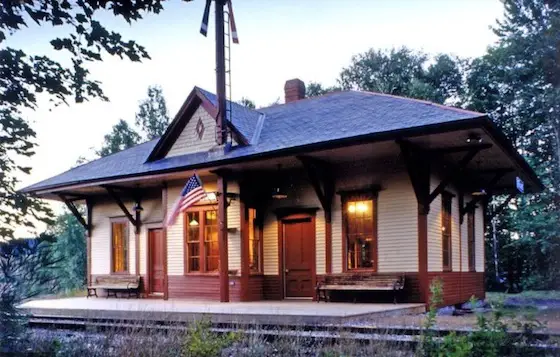
Brick Foundation Problems | Guess how old this brick foundation is? It was constructed in 1891 and has survived 130 harsh New Hampshire winters! Copyright 2021 Tim Carter
How to Prevent Brick Foundation Problems - Go to the BIA
A few weeks ago, a visitor to my AsktheBuilder.com website wanted to know about brick foundations. Karen had this ambitious desire to build a small 900-square-foot house by herself. She was well aware of her physical limitations and asked me if it was possible for her to construct the foundation using standard brick. She had tried to lift an 8x8x16-inch concrete block and discovered those were too heavy. She knew she could handle brick. Karen wanted me to share what she needs to know to build a strong brick foundation.
The issue is she had never seen a house with a brick foundation and because of that thought she might not be able to see her dream come true. From time to time, you’ll hear me say, “You don’t know what you don’t know.” When you apply this to your life experience about all things building, it’s easy to fall into a trap where you feel there are just one or two ways to do something.
Take for example house foundations. You may live in a part of the USA where the foundation contractors use concrete or precast concrete block. If you don’t travel at all or do research about foundation types, then you might come to the conclusion there are just two ways to build a foundation.
But travel to other parts of the USA or the world, and you’ll quickly discover that there are quite a few other ways to build foundations that not only last a lifetime, they last generations. Each time I travel to town to get grocery materials, I pass at least five old houses that have stacked stone foundations with no mortar between the stones! The builder just chinked the gaps between stones with smaller stones. Most of these houses were built in the mid-1800s and they look to me as good as the day they were built.
Travel to Ashland, NH, and stop by the restored Ashland railroad train station. The current building was built around the 1860s or so but was moved about 100 feet in 1891 on top of a distinctive brick foundation.

This is the historic Ashland NH railroad depot. Watch the video below.
The train depot foundation is in fantastic shape to this day with no signs whatsoever of structural cracks or failure. It could use a little tuckpointing, but that’s a minor repair. Karen’s dream is going to come true!
Are All Bricks Equal Strength?
It’s important to realize not all bricks are the same. Brick can have different hardness depending on the length of time they’re in the kiln and what the firing temperature is. You can make brick so hard and durable, they work as paving in streets. Just visit Athens, Ohio to see their wonderful brick streets that have survived heavy trucks, brutal winters, etc. for decades.
Read my past column about different types of brick to get an idea. Be sure you read about lime brick mortar too!
Karen should use a nice strong brick. I told her to go to the Brick Industry Association (BIA) website and download Technical Notes - Specifications for and Classification of Brick 9A. This simple-to-read-and-understand free document shares the best brick to use in a structural situation such as her foundation. She should use a brick that’s rated for severe weathering.
I then shared with Karen that she should look at the entire list of free Technical Notes PDFs offered by the BIA. They contain a wealth of information about how to install brick of all types. You should do the same if you’re planning on building a brick-veneer home. A vast majority of brick-veneer homes here in the USA, based on my observations, are not built correctly. Homeowners routinely complain of water leaks. The BIA knows how to capture and control water that gets through brick and mortar.
Can You Add Reinforcing Steel to Brick Walls?
Yes, you can add reinforcing steel to brick walls. One of the things I recommended to Karen was the use of steel in her brick walls. You can purchase affordable pieces of reinforcing steel that add enormous strength to brick walls. This fabric comes in different widths and is made using two parallel pieces of thin wire that’s just about an inch less in width than the brick wall. In between the two pieces of wire is more wire that looks like a continuous strip of the capital letter W with the tips of the letters touching one another.
This steel is only about 1/16th of an inch thick and you lay it directly on top of a course of brick. You then put the mortar for the next row on the wire just as you would a course without the steel. The BIA Technical Notes talk about the spacing, but I told Karen to do it every 8 inches for extra strength.
How Thick Should a Brick Foundation Be?
The thickness of the brick foundation walls is important. If the foundation walls are over 6 feet, personally I’d have the walls 12 inches thick. You only get one chance to get this right. If the walls are long, every 12 feet I’d put in a brick buttress that’s 8 inches thick and is 2 feet long. Cathedral builders in Europe hundreds of years ago discovered the benefits of buttresses. They’re easy to install and they add enormous strength to the walls preventing them from failing.
The last piece of advice I gave Karen was to build a short experimental wall so she gets comfortable laying brick. It’s not that hard to do. It just requires the three Ds: diligence, determination, and discipline. You can do it too! I’d love for you to send me photos of any brick wall you decide to build.
Column 1423
The post How to Prevent Brick Foundation Problems appeared first on Ask the Builder.
Via Home http://www.rssmix.com/
No comments:
Post a Comment